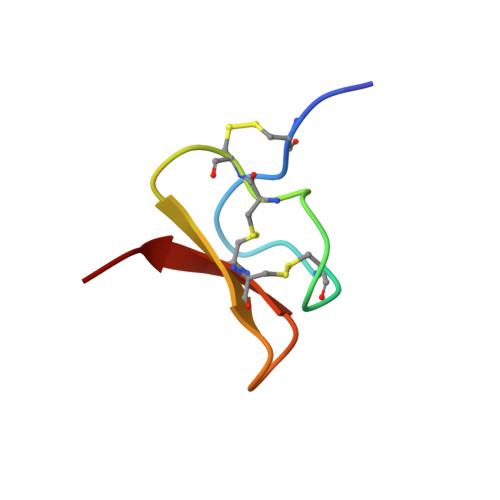Rational Engineering Defines a Molecular Switch That Is Essential for Activity of Spider-Venom Peptides against the Analgesics Target NaV1.7
Klint, J.K., Chin, Y.K., Mobli, M.(2015) Mol Pharmacol 88: 1002-1010
- PubMed: 26429937
- DOI: https://doi.org/10.1124/mol.115.100784
- Primary Citation of Related Structures:
2MQF, 2MXO - PubMed Abstract:
Many spider-venom peptides are known to modulate the activity of the voltage-gated sodium (NaV) subtype 1.7 (NaV1.7) channel, which has emerged as a promising analgesic target. In particular, a class of spider-venom peptides (NaSpTx1) has been found to potently inhibit NaV1.7 (nanomolar IC50), and has been shown to produce analgesic effects in animals. However, one member of this family [µ-TRTX-Hhn2b (Hhn2b)] does not inhibit mammalian NaV channels expressed in dorsal root ganglia at concentrations up to 100 µM. This peptide is classified as a NaSpTx1 member by virtue of its cysteine spacing and sequence conservation over functionally important residues. Here, we have performed detailed structural and functional analyses of Hhn2b, leading us to identify two nonpharmacophore residues that contribute to human NaV1.7 (hNaV1.7) inhibition by nonoverlapping mechanisms. These findings allowed us to produce a double mutant of Hhn2b that shows nanomolar inhibition of hNaV1.7. Traditional structure/function analysis did not provide sufficient resolution to identify the mechanism underlying the observed gain of function. However, by solving the high-resolution structure of both the wild-type and mutant peptides using advanced multidimensional NMR experiments, we were able to uncover a previously unknown network of interactions that stabilize the pharmacophore region of this class of venom peptides. We further monitored the lipid binding properties of the peptides and identified that one of the key amino acid substitutions also selectively modulates the binding of the peptide to anionic lipids. These results will further aid the development of peptide-based analgesics for the treatment of chronic pain.
Organizational Affiliation:
Institute for Molecular Bioscience, (J.K.K., Y.K.-Y.C.), and Centre for Advanced Imaging (M.M.), University of Queensland, St Lucia, Australia.














